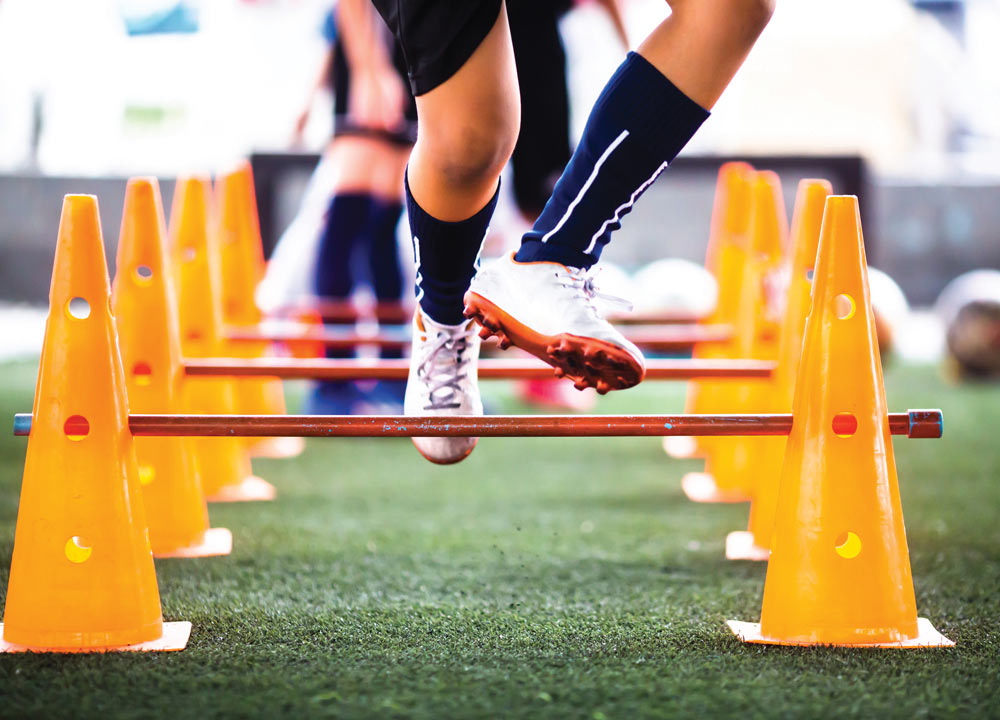 By Justin Sacco, Alex DiCioccio, and Peter Gorman, DC
By Justin Sacco, Alex DiCioccio, and Peter Gorman, DC
Schools, Parks, and ball fields are all steadily opening, and the athletes this summer are once again getting ready to put on a show. Here are six physical tests for our athletes to make sure they are ready to get back on the field.
1. Balance
Balance is the critical component of all movement. Practice standing on one leg. This gives you a simple understanding of balance control. The goal is balancing on each leg for 60 seconds.
1B. Proprioception
Proprioception is known as the hidden factor. When an athlete plays, their eyes are on the game. It is their feet that read the ground. This understanding of where you are in space is known as proprioception. To test proprioception, an athlete will once again stand on one leg with their eyes open. When they feel ready, they will close their eyes and try to maintain balance for 30 seconds without moving. Practice balancing on one leg every day for 5 minutes with your eyes open and eyes closed to improve balance control and proprioception.
2. Soleus Check
The soleus muscle is nicknamed the second heart of the human body because of its ability to send blood back to the heart from the lower extremities. It is also a primary muscle of propulsion- pushing off, starting all movement. Last but not least, because of its attachment at the knee, it is also a protector of the anterior cruciate ligament, aka, the infamous ACL ligament.
To test, stand tall with your feet shoulder width apart and squat down to get your butt to the floor. If you have to lift your heel to allow your butt to go all the way down, we know there is some kind of contraction.
To reduce improper contraction as a means to prevent injury, we recommend foam rolling the calf area with a muscle recovery system. By finding trigger points (tender spots in the muscle) you can reduce them and restore proper muscle function.
 3. Core Strength
3. Core Strength
Core strength is essential as it helps maintain proper pelvic alignment and aids in proper muscle function. To test core strength, stand tall, facing the wall with your toes touching the wall. With your hands behind your head and feet shoulder width apart, squat down and try to get your leg parallel to the floor. (Please have someone spotting you in case on your way down you end up falling backwards.) If your core is weak, you will fall backwards before reaching parallel.
Remember, strength cannot be built on an unstable foundation. Coaches and athletes should not add weight if the athlete cannot perform a front wall squat. Adding weight to an unstable foundation can lead to injury.
4. March in Place
This next test is called the Old Fukuda Test. Make note where you are standing and what direction you are facing. Close your eyes and march in place for 50 seconds. Your body should not move forward or backward and it should not rotate at all. Any movement is a sign of muscle imbalance and should be addressed by your coach or trainer.
5. Upper Body Range of Motion
Athletes must be able to externally and internally rotate their arm while holding their shoulder joint and elbow joint at 90 degrees. We can test this by standing with our back to the wall, putting our shoulder arm at 90 degrees and putting our forearm elbow at 90 degrees. The athlete should easily be able to put the back of their hand to the wall while maintaining the 90-degree angle. The athlete should also be able to put the palm of their hand to the wall at a 90-degree angle. Any reduction in this ability can be a sign of GIRD (Glenohumeral Internal Reduction Deficit) and should be addressed by the coach or trainer.
6. Breathing
We have left this one for last because it affects ALL body functions. Proper breathing might be the most important thing an athlete has to do. If you don’t believe me, try going a few minutes without it and see how it feels. Approximately 83% of people are breathing backwards. We must ensure as we breathe in, our stomach expands outward, and the chest does not rise. To test this, simply place a hand on the stomach and make sure the stomach is expanding upon inhalation. This simple technique will improve VO2 max, respiratory quotation, and tidal volume (all measures of cardiovascular fitness and aerobic endurance).
Obviously, there are many other imbalances of the body. However, this simple checkpoint system should be able to recognize many, if not all, imbalances so that proper efficient play can be had by all.
If there is any deficit in any of the 6 physical tests, the test becomes the training. Continue to practice these to ensure optimal performance.
Here’s to a healthy and productive season.
Justin Sacco works with Microgate USA in Mahopac, New York. He is a former athlete who focuses on coaching physical fitness and injury prevention.
Alex DiCioccio, is an undergraduate at State University of New York – Cortland who works with Microgate USA in Mahopac, New York. He is a future educator who focuses on teaching young athletes the science, skills and knowledge to achieve optimal performance.
Peter Gorman, DC, is the president of Microgate USA in Mahopac, New York, a developer of heart rate monitor technology and owns seven major patents in the United States and Canada.
